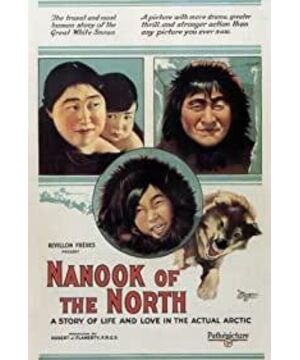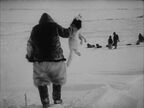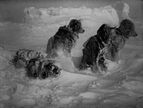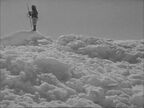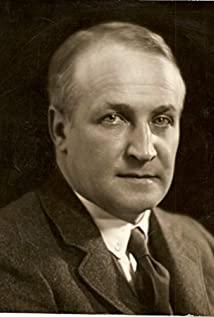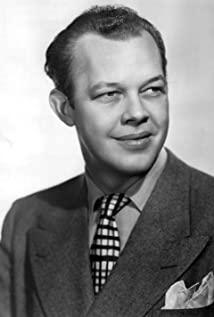The film was shot very smoothly, without a single line, and the narrative was still clear. Basically it is a fixed-camera, fixed-scene shooting, so close close-up shots are rarely zoomed in. In some scenes, the expressions and movements of the characters cannot be seen clearly, such as Nanuk’s wife who wakes up in the morning and bites Nanuk stiffly. Deerskin boots will arouse the audience's anxiety. As the camera moves very little, the shooting angle is single, and the visual and aesthetic fatigue will give the audience a feeling of insufficient refinement and procrastination.
In the few close-up shots, Nanuk uses a spoon to feed the blended oil to the child for digestion. The child’s contented and happy smile is moving, simple, pure, and joyful from the heart, bringing every inch of skin on the child’s face , Every cell is filled.
Just after Fulahadi (Robert Flaherty) documentary Nanook of the North two years to complete, the great people of Eskimo hunter Nanook, starved to death in the Arctic wilderness in the hunt
and modern society completely out of Nanook, at the point of transaction When the white white man used his gramophone to play the sound, he actually bit the vinyl record with his teeth curiously. This is his instinct, that is: what is this thing made of? Can you eat it?
Nanook’s family lives on the icy, snowy, vast ice field where the north wind roars. They eat raw fish and lick the knife with their tongues to make the ice sharp. Their raft can hold five people and a dog, and the clothes are like a fat seal. Leather robe, wives woke up in the morning to bite their husband’s boots soft, because one night the boots were harder than stones, winter came, they made igloo with ice and snow, the snow was so cold that they could be cut into bricks, their dogs were tough and strong. , Bloodthirsty and combative, their baby is naked in the mother's leather robe, and the mother is happy to show him naked to the camera
It is in this modern civilization from so far away, as if the earth is not in the same environment, Nanook in a while to become accustomed to their way of life make us dumbfounded with
the use of parallel montage of the construction of the "Yi Gelu" (that is, the Eskimos live The igloo.) The performance is very good. On one side, the adults build the igloo, and on the other hand, the children "ski". Every time you ski, Dad’s house has already risen by half. They are full of wisdom, because they know how to light, everything is pure and natural.
The scene that moved me the most was that Nanook chose a piece of ice and hewed it into a brick as the window of Igloo. Although this piece of glass is much blurry than the real glass, his wife wiped it from the inside intently, and the North Pole was always tilted. sunshine vague fired into the snow house
is also a great photographer Fulahadi there, he has always demonstrated in modern society to another completely different life, such as Eskimos, the Syrians Islanders. And this way of life, the scene of struggling with the irresistible nature, makes the documentary of the Lumière brothers incomparable.
This film has style characteristics that surpass that of the documentary, and the interesting thing is that its artificial traces are not. Bringing destruction to this documentary, but achieving its poetic reality. We have to admit that once the director picks up the camera, a narrative (not a record) will occur. The recorded thing also starts from Vlahadi’s camera. At the same time, this film also seems to imply how our personal subjective passion can be shared. The authenticity of the record merges (he described this ordinary hunter as a great hunting hero among the Eskimos-there will always be such a hero). Of course, Vlahadi has to capture and edit the pictures and images that he considers valuable. So when you see Nanuk smiling at the camera, this smile is not just a record of facial expressions, but a smile facing the curiosity of Westerners and advanced Western technology-just like Nanuk chewing on a record Fragments of —— from the side of Flahadi, we also see "how the Western spirit describes and interprets distant and exotic civilizations".
What makes this film even more shocking is the peculiar and natural blending relationship between him and the camera that Vlahadi revealed to us through the film. Although Vlahadi did not accumulate any valuable filming experience before this, his love for the artistic vision of film is the same as his love for Eskimos. Vlahadi's spirit of adventure must be expressed in a way. Fortunately, he found it and combined the love of the two perfectly-"It is still very attractive to this day" as evidence.
The narrative of this film is creative, and it also illustrates this feature of the film: the scene of the Eskimo hunting the walrus recorded through the eyes of the camera is by no means a simple narrative. The completely natural icy beauty of the water movement, and then the shooting and hunting process, this is a contrasting poetic narrative-the Eskimos caught a walrus, a sharp weapon pierced into the walrus's body, the rope was held firmly by several Eskimos Grasping, what Fu shows us is the walrus, the tide, the back and forth, and pulling movements of the Eskimos-the silent picture opens a huge space for narrative and interpretation. The use of telephoto lenses, such as shooting scenes where the Nanuk family is out, is not only to obtain the natural feeling of non-professional actors. Perhaps we can assume that in such a vast white world, perhaps the force of nature urged him to use it. This kind of lens language expresses the hard but happy life of the Eskimos.
In the book "Fu" it is mentioned that the Eskimos are full of simple mutual love and friendship. Under such a difficult environment, if such a relationship is not constructed, there is no way to survive. The story told by Vlahadi to the BBC Mentioned: A family of Eskimos camped on a glacier. The ice broke at night. The igloo happened to split into two. The family was divided into two groups and drifted in two different directions. They did not meet again until a few months later. . Similarly, you will also notice that in the close-up shot, the object under the Vlahadi camera seems to be tightly framed by a picture frame. Therefore, if Fu Yue is driven by a strong objective record of truth, then it is inevitable that he needs more subjective perspective to interpret. What Flahadi accomplishes is not the exploration of alien life and civilization, but also a series of derivative art products between him and the camera.
This is Vlahadi’s second time in the North Pole to shoot, and the first film returned was turned into ashes because of a cigarette butt, and it seemed that it was God’s will that made him perfect. When I returned to the Eskimos again, I not only gained trust in getting along with them day and night, making the Nanuk family highly natural in front of the camera, but also perfected the previous shortcomings. It is said that Vlahadi made this film because he witnessed the brutal harm caused by the Industrial Revolution to nature, with the intention of allowing people to relive ancient civilizations. Vlahadi was not the first director to film the Eskimos. However, in the past, when large white racists photographed marginalized peoples, they often looked at the strange customs and wonderful scenery of the colony with arrogant eyes, which was a kind of curiosity and playful mentality. Vlahadi injected a kind of rare humanistic care into "Nanuk of the North". Vlahadi is emotionally connected with the Eskimos, has an attitude of admiration for their pristine and natural way of life, and admires the tenacious vitality of the Eskimos fighting against the difficult living environment. He is like a "troubadour" with a camera, wandering back and forth in marginal ethnic regions, sighing deeply for the disappearance of the ancient culture. It is precisely because of this attitude of understanding and reverence that "Nanuk of the North" far surpasses the past and all subsequent similar films made with curiosity or scrutiny.
In the process of filming "Nanuk in the North", in order to explore life, grasp and organize materials effectively, Flahadi went deep into the field three times, and got along with the subjects day and night, waiting for the "story" to gradually take shape. Vlahadi changed the fancy work method of shooting "travel films" in the past. For the first time, he changed the wandering scenes from custom and curiosity to long-term tracking of an Eskimo family, showing their dignity, wisdom, and concern. The emotions and fate of the characters, and respect their cultural traditions. This recording method of choosing a specific subject-aiming the camera at an Eskimo and his family can be summarized as "three ones": a protagonist, a main line, and a theme. This shooting mode is still respected by documentary filmmakers to this day.
With the help of the local representative of Revignon, Flahadi found Nanuk as the subject. Under the influence of Vlahadi, Nanuk fell in love with movies. He not only actively cooperated with Vlahadi, but also gave Vlahadi a lot of ideas. As a guide, Nanuk not only brought Vlahadi into the life of each Eskimo, but also brought him into a vibrant cultural tradition. During the filming process, Vlahadi and the Eskimos get along with each other day and night. The recording method Vlahadi pioneered was to organically blend the filming activities with real-life interactions between people. This kind of shooting method of coexisting with the subject for a long time to grasp its true appearance has been adopted by documentary writers for a long time. To this day, how to communicate with the subject is still one of the most basic propositions that every documentary worker has to face on the shooting scene.
"Nanuk of the North" is not only the result of Vlahadi's shooting in one year and four months. As Eric Barno said: It is also the product of the fusion of Vlahadi and the Eskimos. It is Vlahadi’s admiration for the uncivilized national culture, regrets that this precious culture is about to die out, and the entry of Western civilization. The confusion of the localized area, and even the confusion of one's own behavior, etc. are crystallized by emotions. It is also the culmination of Vlahadi's three Arctic expeditions, so it will have such a big impact. It not only created a type of anthropological documentary that used images to record society, but also provided a shooting mode that is still in use for documenting movies.
"Nanuk of the North" is the glorious starting point of world record film history. In 1964, at the Mannheim Film Festival, "Nanuk of the North" ranked top in the world's excellent documentary competition. As the pioneering work of documentary, this film shot in the 1920s is really amazing.
View more about Nanook of the North reviews


